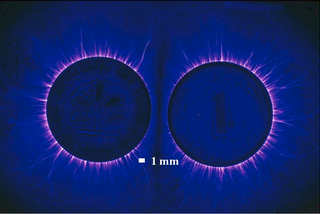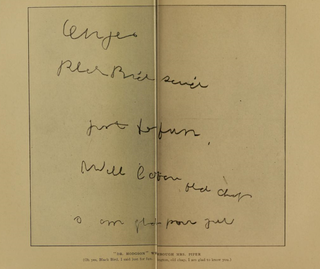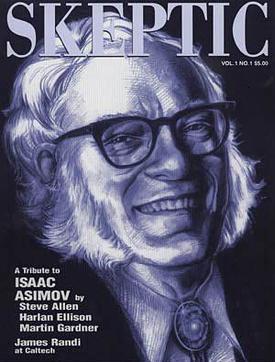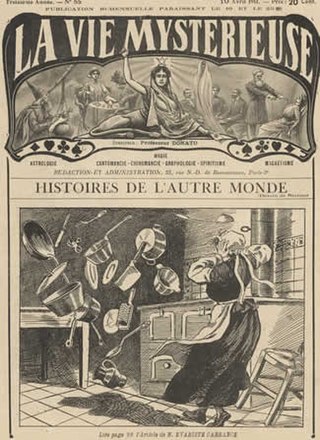Related Research Articles
Cryptozoology is a pseudoscience and subculture that searches for and studies unknown, legendary, or extinct animals whose present existence is disputed or unsubstantiated, particularly those popular in folklore, such as Bigfoot, the Loch Ness Monster, Yeti, the chupacabra, the Jersey Devil, or the Mokele-mbembe. Cryptozoologists refer to these entities as cryptids, a term coined by the subculture. Because it does not follow the scientific method, cryptozoology is considered a pseudoscience by mainstream science: it is neither a branch of zoology nor of folklore studies. It was originally founded in the 1950s by zoologists Bernard Heuvelmans and Ivan T. Sanderson.

Clairvoyance is the claimed psychic ability to gain information about an object, person, location, or physical event through extrasensory perception. Any person who is claimed to have such ability is said to be a clairvoyant.

Kirlian photography is a collection of photographic techniques used to capture the phenomenon of electrical coronal discharges. It is named after Semyon Kirlian, who, in 1939, accidentally discovered that if an object on a photographic plate is connected to a high-voltage source, an image is produced on the photographic plate. The technique has been variously known as "electrography", "electrophotography", "corona discharge photography" (CDP), "bioelectrography", "gas discharge visualization (GDV)", "electrophotonic imaging (EPI)", and, in Russian literature, "Kirlianography".

Parapsychology is the study of alleged psychic phenomena and other paranormal claims, for example, those related to near-death experiences, synchronicity, apparitional experiences, etc. Criticized as being a pseudoscience, the majority of mainstream scientists reject it. Parapsychology has also been criticised by mainstream critics for claims by many of its practitioners that their studies are plausible despite a lack of convincing evidence after more than a century of research for the existence of any psychic phenomena.

Fortune telling is the practice of predicting information about a person's life. The scope of fortune telling is in principle identical with the practice of divination. The difference is that divination is the term used for predictions considered part of a religious ritual, invoking deities or spirits, while the term fortune telling implies a less serious or formal setting, even one of popular culture, where belief in occult workings behind the prediction is less prominent than the concept of suggestion, spiritual or practical advisory or affirmation.

The Committee for Skeptical Inquiry (CSI), formerly known as the Committee for the Scientific Investigation of Claims of the Paranormal (CSICOP), is a program within the U.S. non-profit organization Center for Inquiry (CFI), which seeks to "promote scientific inquiry, critical investigation, and the use of reason in examining controversial and extraordinary claims." Paul Kurtz proposed the establishment of CSICOP in 1976 as an independent non-profit organization, to counter what he regarded as an uncritical acceptance of, and support for, paranormal claims by both the media and society in general. Its philosophical position is one of scientific skepticism. CSI's fellows have included notable scientists, Nobel laureates, philosophers, psychologists, educators, and authors. It is headquartered in Amherst, New York.
Scientific skepticism or rational skepticism, sometimes referred to as skeptical inquiry, is a position in which one questions the veracity of claims lacking empirical evidence. In practice, the term most commonly references the examination of claims and theories that appear to be beyond mainstream science, rather than the routine discussions and challenges among scientists. Scientific skepticism differs from philosophical skepticism, which questions humans' ability to claim any knowledge about the nature of the world and how they perceive it, and the similar but distinct methodological skepticism, which is a systematic process of being skeptical about the truth of one's beliefs.

Automatic writing, also called psychography, is a claimed psychic ability allowing a person to produce written words without consciously writing. Practitioners engage in automatic writing by holding a writing instrument and allowing alleged spirits to manipulate the practitioner's hand. The instrument may be a standard writing instrument, or it may be one specially designed for automatic writing, such as a planchette or a ouija board.
The Skeptics Society is a nonprofit, member-supported organization devoted to promoting scientific skepticism and resisting the spread of pseudoscience, superstition, and irrational beliefs. The Skeptics Society was co-founded by Michael Shermer and Pat Linse as a Los Angeles-area skeptical group to replace the defunct Southern California Skeptics. After the success of its magazine, Skeptic, introduced in early 1992, it became a national and then international organization. The stated mission of Skeptics Society and Skeptic magazine "is the investigation of science and pseudoscience controversies, and the promotion of critical thinking."

Skeptic, colloquially known as Skeptic magazine, is a quarterly science education and science advocacy magazine published internationally by The Skeptics Society, a nonprofit organization devoted to promoting scientific skepticism and resisting the spread of pseudoscience, superstition, and irrational beliefs. First published in 1992, the magazine had a circulation of over 50,000 subscribers in 2015.
Psychometry, also known as token-object reading, or psychoscopy, is a form of extrasensory perception characterized by the claimed ability to glean accurate knowledge of an object's history by making physical contact with that object. Supporters assert that an object may have an energy field that transfers knowledge regarding that object's history.

Marcello Truzzi was a professor of sociology at New College of Florida and later at Eastern Michigan University, founding co-chairman of the Committee for the Scientific Investigation of Claims of the Paranormal (CSICOP), a founder of the Society for Scientific Exploration, and director for the Center for Scientific Anomalies Research.

Pyramidology refers to various religious or pseudoscientific speculations regarding pyramids, most often the Giza pyramid complex and the Great Pyramid of Giza in Egypt. Some "pyramidologists" also concern themselves with the monumental structures of pre-Columbian America, and the temples of Southeast Asia.
Rosemary Altea is a British author who describes herself as a medium and healer. She has appeared on various programs, including Larry King Live, The Oprah Winfrey Show, and featured in the series premiere of Penn & Teller: Bullshit! alongside mentalist Mark Edward. She has written six books and claims to have a "healing foundation".

Flim-Flam! Psychics, ESP, Unicorns, and Other Delusions is a 1980 book by magician and skeptic James Randi about paranormal, occult, and pseudoscience claims. The foreword is by science fiction author Isaac Asimov. Randi explores topics which he says that scientists and the media are too willing to promote without skepticism and proper expertise.

Telekinesis is a hypothetical psychic ability allowing a person to influence a physical system without physical interaction. Experiments to prove the existence of telekinesis have historically been criticized for lack of proper controls and repeatability. There is no reliable evidence that telekinesis is a real phenomenon, and the topic is generally regarded as pseudoscience.

Psychic archaeology is a loose collection of practices involving the application of paranormal phenomena to problems in archaeology. It is not considered part of mainstream archaeology, or taught in academic institutions. It is difficult to test scientifically, since archaeological sites are relatively abundant, and all of its verified predictions could have been made via educated guesses.

Semyon Davidovich Kirlian was a Soviet inventor and researcher of Armenian descent, who along with his wife Valentina Khrisanfovna Kirlian, a teacher and journalist, discovered and developed Kirlian photography.

Joseph Francis Rinn (1868–1952) was an American magician and skeptic of paranormal phenomena.
References
- 1 2 3 Bovis, Antoine. "Excerpt from Exposé de M.A. Bovis au Congrès International de Radiotellerie à Nice". (Nice: Bovis, c. 1935). Translation by Jean-Paul Buquet. Skeptic.com. Retrieved November 24, 2008.
- ↑ Drbal, Karel. Patenti Spis c. 91304. (Prague: 1959).
- ↑ "some people report having been 'so energized that they could not cope with the dynamo effects they experienced'" Toth, Max, and Greg Nielson. Pyramid Power. (New York: Warner Destiny, 1976). 165.
- ↑ Toth, Max, and Greg Nielson. Pyramid Power. (New York: Warner Destiny, 1976). 177.
- ↑ De Mattia, Joan Ann. "Enjoying the Fruits of Pyramid Energy." Pyramid Power, edited by Max Toth and Greg Nielson. (New York: Warner Destiny, 1976). 198.
- ↑ Linse, Pat. (2002). Pyramids: The Mystery of Their Origins. In Michael Shermer. The Skeptic Encyclopedia of Pseudoscience. ABC-CLIO. pp. 397-412. ISBN 1-57607-654-7 "If pyramid power really existed it would be wonderful indeed... But no scientific tests to date have managed to detect it."
- ↑ Neher, Andrew. (2011). Paranormal and Transcendental Experience: A Psychological Examination. Dover Publications. pp. 262-264. ISBN 0-486-26167-0 "There is no satisfactory evidence to support the theory of pyramid power. Although the pyramids are impressive structures, their particular construction—their shape and geographical orientation—does not seem to be capable of altering fundamental physical processes."
- ↑ Nickell, Joe. (2004). The Mystery Chronicles: More Real-Life X-Files. University Press of Kentucky. pp. 200-206. ISBN 0-8131-2318-6
- ↑ Drbal, Karel. "The Struggle for the Pyramid Patent." Pyramid Power, edited by Max Toth and Greg Nielson. (New York: Warner Destiny, 1976). 143.
- ↑ Loxton, Daniel. "Junior Skeptic #23: Pyramid Power". (Altadena: Skeptics Society, 2006). 81–83
- ↑ Laigaard, Jens. "excerpt from Chapter Eight of Pyramideenergien – kritisk undersøgelse". (1999). Translation by Daniel Loxton and Jens Laigaard. Skeptic.com. Retrieved November 24, 2008.
- ↑ Ostrander, Sheila, and Lynn Schroeder. Psychic Discoveries Behind the Iron Curtain. (New Jersey: Prentice-Hall, 1970). 340.
- ↑ Loxton, Daniel. "Junior Skeptic #23: Pyramid Power". (Altadena: Skeptics Society, 2006). 83
- ↑ Bovis, Antoine. "Exposé de M.A. Bovis au Congrès International de Radiotellerie à Nice" (PDF). (Nice: Bovis, c. 1935.) PDF scan of original hosted at Skeptic.com.
- ↑ Drbal, Karel. “The Struggle for the Pyramid Patent.” Pyramid Power, edited by Max Toth and Greg Nielson. (New York: Warner Destiny, 1976). 141.
- ↑ Drbal, Karel. "Patenti Spis c. 91304. (Prague: 1959)". English translation hosted at www.amasci.com. Retrieved November 2008.
- ↑ Loxton, Daniel. "Junior Skeptic #23: Pyramid Power". (Altadena: Skeptics Society, 2006). 88.
- ↑ Loxton, Daniel. "Junior Skeptic #23: Pyramid Power". (Altadena: Skeptics Society, 2006). 82.
- ↑ Coleridge, Gilbert. Letter. The Times. 7 Oct. 1933.
- ↑ Grange, William D’Oyly. Letter. The Times. 19 Oct. 1933.
- ↑ Ostrander, Sheila, and Lynn Schroeder. Psychic Discoveries Behind the Iron Curtain. (New Jersey: Prentice-Hall, 1970). 339-340.
- ↑ Ostrander, Sheila, and Lynn Schroeder. Psychic Discoveries Behind the Iron Curtain. (New Jersey: Prentice-Hall, 1970). 342.
- 1 2 Loxton, Daniel. "A Conversation with Max Toth". Skeptic.com. Retrieved 1 December 2008.
- ↑ Toth, Max and Greg Nielson. Pyramid Power. (New York: Warner Destiny, 1976).
- ↑ Flanagan, Patrick. Pyramid Power (Santa Monica: Pyramid Power – V, Inc, 1975).
- ↑ Ostrander, Sheila, and Lynn Schroeder. Psychic Discoveries Behind the Iron Curtain. (New Jersey: Prentice-Hall, 1970). 339-348.
- ↑ Ostrander, Sheila, and Lynn Schroeder. Psychic Discoveries Behind the Iron Curtain. (New Jersey: Prentice-Hall, 1970). 431.
- ↑ Gardner, Martin (1985). "Pyramid Lake". The Magic Numbers of Dr. Matrix. Buffalo, NY: Prometheus Books. pp. 158–172. ISBN 0-87975-144-4.
- ↑ Pyramid House website
- ↑ (Satellite via Google)
- ↑ (Summerhill Winery Pyramid Story)
- ↑ "Leafs employ 'pyramid power,'" The Associated Press, Saturday, April 24, 1976.
- ↑ Hines, Terence. (2003). Pseudoscience and the Paranormal. Prometheus Books. p. 306. ISBN 1-57392-979-4
- ↑ "Jet Pack". MythBusters . Season 3, Episode 32. June 9, 2005. Discovery Channel.